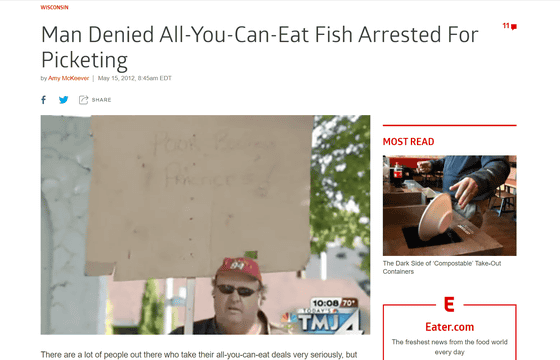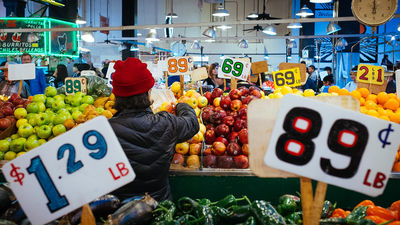Why is the all-you-can-eat buffet style economical?

When you go to a dessert buffet or lunch buffet that sings “all you can eat for a fixed price,” many people will just eat and drink with an intense “Let's take the source”. The all-you-can-eat and all-you-can-eat buffet style may seem like a loss for the shop at first glance, but it is a successful business. The international news media the Hustle explains why buffet style doesn't hurt.
The tricky economics of all-you-can-eat buffets
◆ Reduce labor and raw material costs
The Hustle surveyed the prices of 30 all-you-can-eat plans deployed throughout the United States, and on average it was about $ 20 (about 2200 yen), the breakdown of which was $ 7.40 (about 800 yen) for raw material costs and labor costs I found that $ 6.00 (about 660 yen), rent and tenant fee was $ 2.8 (about 300 yen), other expenses were $ 2.8, and net profit was about 5%, $ 1 (about 110 yen).
The all-you-can-eat plan has a low profit margin and needs to attract a large number of customers. One store in the all-you-can-eat chain `` Golden Coral '' with 498 stores in 42 states has a floor area of 5,000 square feet (about 465 square meters) and seats for 475 people are secured, especially on Saturday with many people , More than 900 people use it. However, it is difficult for ordinary restaurants to handle such a large number of people.
Food consultant Joe Ericsson points out that the advantage of a buffet style is that it saves labor costs: `` In a typical restaurant, one cook can serve up to 25 people per hour. But the buffet style cooks a lot of dishes at once, so one cook could prepare 200 dishes per hour. '
In addition, buffets that can make a large number of dishes at one time have the advantage that purchasing large quantities of ingredients reduces raw material costs. The Hustle calculated using data from food wholesalers, and the raw material cost for one serving was $ 0.30 for french fries, $ 0.50 (about 55 yen) for salad, $ 0.75 for pasta (about 75 yen) ), Roast chicken was reduced to $ 1.13 (about 120 yen) and steak was reduced to $ 2.25 (about 250 yen).

However, one of the drawbacks of the buffet is that it is difficult to predict the amount of food to prepare, and according to a
◆ Techniques to make customers eat more
Buffet-style prices are fixed and no matter how much you eat, the price will not fluctuate. The aim of such a buffet-style store is to 'fill the customer's stomach as quickly as possible and as cheaply as possible.' For this reason, buffet-style restaurants often place cheap and bloating dishes such as potatoes and rice on the first tray. A 2013 study found that 75% of guests at the buffet picked up dishes on the first tray and 66% of the food they ate was taken from the first three trays That

In addition, it was
Also, according to the Hustle, we found that some luxury hotel buffets adopted a strategy of `` place menus using high-quality ingredients such as truffles, foie gras, oysters in confusing places '' .
◆ Most people can't take all-you-can-eat
The average profit per person is $ 1, $ 3.70 (about 400 yen), and-$ 8.50, respectively, when classified into three patterns: customers who eat the average amount, customers who eat less than the average, and customers who eat more than the average. (About 930 yen deficit). However, assuming 300 customers, 225 customers eat the average amount, 60 people eat small meals, and 15 people eat large meals, so if you calculate by applying this ratio , The total profit is $ 319 (about 35,000 yen). In other words, most all-you-can-eat customers cannot eat enough to cost the store, and the restaurant as a whole does not hurt.

Another strategy is to make a profit by selling soft drinks individually in the buffet style. Since the cost of soft drinks is very low, the ratio of gross profit to the purchase price seems to exceed 1000% even if sold for $ 2 per cup (about 220 yen).
However, if a large number of gluttonous customers come in and continue to eat for a long time, of course, the loss of the restaurant will increase rapidly, so restaurants that use buffet style often have a time limit. Troubles between the over-eating patrons and the restaurant, who are willing to eat, caused a total of 20 fried fish to be kicked out of the restaurant at a Wisconsin buffet-style restaurant in 2012. The state of protest was reported.
Man Denied All-You-Can-Eat Fish Arrested For Picketing-Eater
https://www.eater.com/2012/5/15/6586551/man-denied-all-you-can-eat-fish-arrested-for-picketing

Related Posts:
in Food, Posted by log1i_yk







